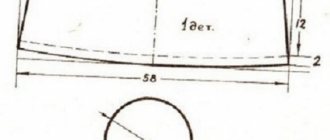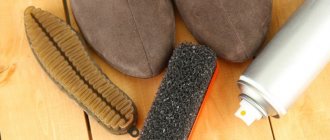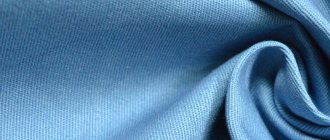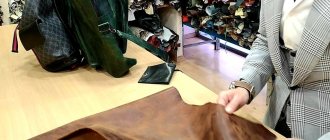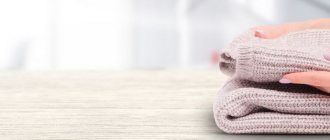What is suede
Natural suede is the skin of small animals produced through tanning (fat or formaldehyde-fat). It is soft, thin, without a front layer: the material is uniformly velvety on both sides. Due to its plasticity, strength, and water resistance, it is suitable for the manufacture of clothing, shoes, and accessories. In the 17th century, thick suede made from the skin of bulls and buffalos was widely used; later it began to be made from the skin of sheep, deer, roe deer, and elk. It comes in the following types:
- refined - thin, “breathable”, obtained from deer, goat, chamois skins;
- unrefined - from sheep and calf skins that are difficult to strong mechanical influences.
History of appearance
Since the 9th century AD, artisans have treated animal skins with chicken yolks, rapeseed oil, pork and lamb lard. So she served longer. At the beginning of the 18th century, near Biarritz, cod oil, blubber (whale and seal oil), and vegetable mixtures began to be used to tan the skins of goats and chamois. From northern Europe through Poland, the technology for the production of “soft leather” reached Russia. The tanners of Novgorod were called from the word “irha” (suede) - ireshniki; in Arkhangelsk, suede was called “flesh”, “vezh” (cleanse the skin in a special way), and leather – “flesh”, “vezh”.
How is suede made?
There are two types of natural suede, and their appearance and quality depend on what kind of leather was used:
- To obtain a non-refined variety, the skins of sheep and calves are taken. It turns out to be a little denser on one side, but the skin on the meat part is extremely delicate, so it does not tolerate mechanical stress well.
- A refined variety of suede is made from the skins of deer, goats and chamois. It is extremely soft, thin and breathable. It is from this that modern designers create their masterpieces.
Manufacturing and properties of natural suede
Animal skin, which has gone through the dressing stage through tanning substances (vegetable oils, fish, bone, and seal fat), acquires plasticity, strength, softness, and double-sided velvety. That's why designers love it so much. Suede-making is a complex process that takes place in several stages using special impact machines, similar in principle to the processes used for the fermentation of various substances.
Suede process
The suede procedure is a long physical and chemical process, multi-stage and complex. Production stages:
- Golie (raw leather without wool) is prepared from the skins of chamois, antelope, goats, sheep, cows, and deer.
- Lubricate the shin with fat (fish, bone, seal, linseed or hoof oil).
- Placed in impact grinders for 3-5 hours, where fats penetrate into the skin and bind to the skin protein, producing oxidation through special microorganisms.
- The skins are folded to warm up, smeared with fat again, and placed in the grinders. This is done several times.
- Properly roasted skins acquire a yellow-brown color, become soft, and their self-heating stops.
- The skins are washed in a solution of potash, degreasing them. The leather is initially permeable to water and then becomes water resistant.
- Waterproof raw materials are sent for painting.
How is it different from nubuck?
Nubuck is used in shoe production. This soft, almost imperceptible material is obtained from cattle hides by tanning and grinding the skin with fine abrasive materials. The difference between nubuck and natural suede:
- Skins for making. For nubuck, take the skin of large animals (cow, deer, elk), for suede - small horned animals (sheep, rams, chamois, antelope, goats).
- Skin processing. For suede leather, animal and vegetable fats (reindeer, fish, flaxseed) are used - the fat method. Nubuck is made by grinding the front side with sand, mineral salts or other abrasive components. This type of treatment is called chrome tanning.
- External difference. The suede pile is more noticeable, higher, the fabric on both sides is velvety, viscous, porous. The pile of nubuck is smaller, lower, present only on the front side, the fabric is harder, in order to increase water resistance it is oiled, the result is nubuck oil.
- Functionality. Suede shoes are wear-resistant, allow air to pass through, preventing moisture from getting inside, while nubuck shoes get wet, greasy, and the oil layer gets dirty.
- Care. You can wash suede products with warm soapy water; you cannot wash nubuck leather; you can only clean it with special products.
Kinds
Many people are interested in what suede is, what it is made of, and what kind of leather it is made of. Deer, sheep and goat skins produce the finest, softest skins, while pork skins produce rough but thin skins. Suede made from the skin of large animals is thick. Previously, it was used to make military uniforms, clothing for hunters and travelers. Now used in the production of footwear and orthopedics.
Split leather example
There is another type - split leather. It is obtained by cutting horizontal layers of several layers of cattle hide. The output is rough, thin, strong non-woven suede.
Note! In addition to natural suede, there is also artificial suede, which is much cheaper.
What is faux suede
A fabric that imitates the original, which has become widespread due to its practicality, low cost, and external resemblance to natural ones - artificial suede. Its basis is synthetic fiber, fabric (cotton or silk), the front side has a pile obtained by splitting microfiber into small fibers or by gluing the pile onto the base. Artificial fabric has good drape, it fits the figure, does not fade, after washing, you don’t have to iron it, and by spraying polymer material onto the base in layers, you get artificial nubuck. Care instructions:
- It is better to wipe dirty areas with a weak solution of ammonia or vinegar with a foam sponge, without effort;
- Wash by hand in cold water, or machine wash only on delicate cycle;
- The product does not need to be ironed;
- Vacuum upholstery regularly; remove dirt in the direction of the pile with washing powder, salt, an eraser, and a soft brush.
What are they made from?
Faux suede is difficult to distinguish from real one. This material can be laminated with cotton, fur, or thin, unduplicated, with perforation or spraying. The base fabric for production is natural (cotton, silk) or synthetic. The ratio of 25% cotton and 75% polyester fiber is optimal for obtaining an unpretentious, durable base. The top of the artificial canvas is covered with characteristic villi; this process happens:
- Woven. Microfiber threads split into fine pile are glued to the base-substrate. This material is resistant to stretching, is not susceptible to creases, and is suitable for the production of gloves, raincoats, and jackets.
- Non-woven. Polyester fibers are sprayed onto a primed base with an adhesive composition. For greater practicality, they are coated with Teflon impregnation. Used for upholstery.
Production technology
The method of producing artificial material can be woven or non-woven. The difference between production technologies is as follows:
- On a woven basis. PVA-based glue is applied to the primed fabric backing (the primer levels the base and prevents glue from seeping through), and a polyester suede covering is applied on top. Such production is more expensive, but better quality.
- Non-woven. It is produced on a brush machine by splitting the microfiber threads into fibers. This is an electrostatic method. The fabric turns out beautiful, but without a base it quickly wears out, so it is glued to the base (knitted, non-woven, woven) hot or cold, and covered with Teflon impregnation.
Properties of artificial suede
Polyester or microfiber fibers applied to a base made of natural fabrics or synthetics - this is what artificial suede is. The quality is almost like natural, but has its own characteristics. Properties of artificial fabric:
- Durability, high strength. This fabric does not stretch, does not wear out, is not subject to deformation, creasing, formation of creases, scratches, cracks, holes, wear-resistant, and is not afraid of direct sunlight.
- The material is pleasant to the touch. It feels soft, elastic, homogeneous, velvety, and looks similar to natural.
- Homogeneous, uniform color that does not fade over time, looks aesthetically pleasing.
- It is easy to clean. It is treated with Teflon impregnation, which repels dust, dirt, and water.
- Uniform density, which is not the case with natural leather, which is heterogeneous in texture.
- "The Writing Effect". By running your hand over the surface of the canvas, you can see that the fibers leave a mark, changing their position.
- Uniform distribution of static electricity, does not stick to the skin.
- Allows the skin to breathe, warms in winter, cools the body in hot weather.
- Easy to care for. It is permissible to wash clothes, but the upholstery for the sofa should be occasionally vacuumed and wiped with a sponge with a special cleaning agent.
- Disadvantages: does not tolerate strong friction, is damaged by animal claws, does not withstand high humidity (use of ammonia solution is acceptable, dry cleaning), light-colored material quickly gets dirty.
Manufacturing stages
What is natural suede made from? Dressing has its own characteristics. The raw material used is the skin of sheep, goats, pigs or deer.
At the first stage, the top layer of dense, hard, slightly elastic tissue is removed from it - the flesh (the so-called fleshing). Next, fatliquoring (suede) is carried out, cod, seal, whale fat (blub) or other fat of plant and animal origin is injected into the skin. During this process, the fat chemically bonds with the fibers of the leather and makes it soft and water-resistant.
Nowadays, formaldehyde treatment and then fatliquoring are mainly used. At the last stage, grinding machines are used to speed up the process. The finished material is brown in color, and can then be further processed with abrasive to create lint on the surface.
You might be interested in this: Features of the production and operation of neoprene fabric
Wild goat chamois
How to distinguish artificial suede from natural one
Visually, natural and artificial leather are very similar; it is difficult for an inexperienced person to identify a fake. You can recognize original suede like this:
- Natural material, scratches, porosity, microcracks on which are noticeable, looks natural, heterogeneous. The surface of the substitute is perfectly smooth, without scratches.
- The texture of natural canvas is uneven, the thickness changes from the center to the edge, so the color also turns out to be uneven. The thickness of the artificial suede is uniform throughout the entire canvas, the color is perfectly uniform.
- To the touch, the structure of natural leather is delicate, elastic, flowing, velvety, soft, and loose, while the structure of artificial leather is rough.
- If you smell the material, you can catch the leathery, tart aroma of suede; the artificial one smells like synthetics, paint, glue, or there is no smell.
- By running over the pile of a natural fabric, you can find that the shade of the mark has become lighter - the piles have changed their slope. On an artificial one, the pile almost immediately returns to its place, the mark disappears.
- Suede heats up from prolonged touch, but the temperature of the artificial fabric remains the same.
- The natural material is visible from the cut: the edges of the jacket and shoes do not bend, the cut is solid. Artificial suede is folded along the edge; the fold has a fabric layer for attaching polymer fibers.
- Genuine leather will absorb water almost immediately, leaving a dark stain; with artificial leather, a drop will roll off or remain on the surface.
- The cost of natural suede is much higher.
Advantages and disadvantages of the material
Natural and artificial suede are very similar in appearance. But these fabrics differ in their performance properties.
Natural material is stronger and lasts longer. You can determine what fabric an item is made from using the following features:
- natural smells like leather, artificial has a slight chemical smell;
- natural suede has a clearly visible porous structure;
- The thickness of the fabric of natural suede is not the same everywhere;
- the pile of artificial fabric is lighter at the base, darker at the top;
- natural fabric is always expensive.
The advantages of natural suede include:
- good breathability;
- ability to retain heat;
- soft surface;
- elegant appearance;
- strength.
One of the disadvantages is the rather high cost. Since the material is electrified, it collects dust and small debris, the clothes have to be constantly cleaned. The action of water causes suede to become deformed.
Review of the pros and cons of fabric:
Application and Use
Things made from natural material are convenient, soft, light, comfortable, do not allow moisture to pass through, look elegant, and speak of the good taste of their owner. Suede is used for sewing outerwear, shoes, and accessories. Designers, fashionistas, and stylish men adore her. Areas of application:
- When sewing clothes. Used for outerwear: sheepskin coats, coats, jackets, trench coats.
- Shoes and accessories. The price of suede is higher compared to other materials; shoes, jewelry, bags, gloves, and straps made from expensive fabric are considered luxury.
- Furniture upholstery. For this purpose, artificial canvas is often used as it is more unpretentious, practical, and will not become deformed.
- In optics. Used for grinding lenses and optical surfaces.
- It is widely used in orthopedics due to its antiallergic properties, special softness, and moisture resistance.
When sewing clothes
Clothes are made from natural and artificial fabric. Sewing features:
- Natural suede is used to make outerwear (jackets, raincoats, sheepskin coats, coats).
- Artificial, obtained by woven method, is used for sewing outer demi-season and winter clothing (raincoats, jackets), trousers, dresses, shirts, skirts, blouses. For cutting, ordinary scissors are used, the needles are sharp, as for sewing jeans. Puncture holes may be visible when cutting, so cutting must be done carefully. Additionally, it is not necessary to bend or process the edges with an overlocker; you can make the edge zigzag with special scissors. Loose styles of the product will help better penetration of air to the body.
- How to open a bottle of wine without a corkscrew
- How to treat fingernail fungus
- How to eat to lose weight
Shoes and accessories
Suede shoes are always relevant, elegant, never go out of fashion, and can be combined with a variety of clothes. At the peak of popularity are suede stocking boots that will perfectly complement any look. Winter suede boots, due to their breathability, waterproofness, and lightness, are more practical than similar leather models. In such shoes, the foot does not sweat, keeping perfectly warm. Split leather is used to make shoes and accessories: thick, layered skins of large animals. This material is used in mass production and is cheaper than other types.
Upholstery
For furniture upholstery, it is more practical to use artificial suede obtained using a non-woven method. This material is cheaper and more unpretentious than its natural counterpart. Suede upholstery enhances furniture, is pleasant to the touch, is not subject to deformation or defects, is durable, does not fade over time, and is suitable for any interior style. It does not tolerate wet cleaning and is damaged by mechanical friction, but with the help of a vacuum cleaner and careful cleaning with a sponge and a special product it will last a very long time.
In optics
Natural, lint-free suede is suitable for practical use in the precision and optical industries. Perfectly absorbing moisture without leaving marks or scratches on the surface of the lens, it is used for wiping and polishing. In everyday life, a microfiber cloth is used that destroys microorganisms and household dirt. Capable of removing stains and fingerprints from plasma TVs, LCD monitors, and photo lenses.
In orthopedics
Suede orthopedic shoes, thanks to their modern design, natural breathable materials, variety of colors, are comfortable to wear and pleasing to the eye. For the production of insoles and orthopedic shoes, technical suede is used (GOST 3717-84). It is made using a fatty, formaldehyde-fat tanning method for tanning the skins of goats, milk, deer, and sheep. Such raw materials are yellowish-brown in color, with short pile.
Differences between natural and artificial materials
Suede is a good material that has a number of remarkable properties. Looks beautiful, soft, pleasant to the touch. Disadvantage: expensive. Manufacturers have come up with a number of artificial materials that are cheaper, do not allow water to pass through, and do not quickly deteriorate in appearance. These include velor, faux suede, leather, eco-leather.
You might be interested in this Description of the properties, characteristics and appearance of guipure fabric in different colors
Artificial material
Velor is a type of fabric with pile. It is not leather; rather, it is a type of textile used for upholstery of car interiors and furniture.
There is eco-leather, or leatherette in other words. Eco-materials are not so soft. Leatherette is a material based on fabric: a polymer film is applied to it. The products are elastic, do not change color, do not get wet and do not allow water to pass through. Leatherette is sensitive to high temperatures.
Faux suede is a fabric base coated with polyester, which creates a pile. It looks like suede, but the color is uniform and can have many colors. It is afraid of solvents and bleaches, washes well and does not lose its properties.
Rules of care
Suede is a capricious material. If you have a lot of suede items in your wardrobe, it is advisable to know the operating conditions. How to properly care for suede:
- After purchase, it is recommended to treat the suede item with a protective agent (silicone or fluorocarbon aerosol impregnation).
- If the item begins to shine, you need to take it to the dry cleaner. You can clean the product at home by washing it in a warm solution with soap, shampoo, or use a special product for suede - wash very quickly, avoiding significant wetting, without strong friction. Don't squeeze! Wipe without twisting with a cloth.
- It is allowed to clean heavily soiled areas with a special brush (rubber, brass, rubber) with metal bristles or a sponge.
- Suede items are dried at room temperature on a dryer, hanger (if they are clothes), indoors, never near heating radiators or in the open sun. The dried item is lightly kneaded with your hands and cleaned with a special soft brush, straightening it and lifting the pile.
- You can update the color using special spray paint.
To remove stains from the surface, do not use stain removers or substances containing acetone. You can use homemade cleaning products:
- add half a teaspoon of soda to milk (0.5 cup), wipe off the dirt with the solution and then with a damp cloth;
- light suede is cleaned with a mixture of magnesia, talc, turpentine, milk (in the same ratio);
- greasy stains are removed with a mixture of starch and ammonia;
- A regular eraser removes fresh, light stains.
How to care for suede shoes
It is necessary to promptly clean dirt and handle suede shoes with care. Rules of care:
- Before use, treat shoes with an aerosol protective agent.
- If dirt gets on your shoes, let it dry, then brush off the dirt. You can't over-dry your shoes.
- Hold the boots over the steam and clean them again, rubbing the shiny areas with a special brush or eraser. Brush treatment in one direction.
- Light suede shoes are cleaned with a solution combining magnesia, talc, turpentine, and milk in equal proportions.
- Salt stains disappear when removed with a 5% vinegar solution.
Outerwear care
Suede outerwear is warm, comfortable, breathable, and does not increase sweating. Clean the product in one direction with a rubber brush. Rules of care:
- Dirt stains that get on the jacket should first be dried, then shaken off with the metal side of the brush, and cleaned with the silicone side.
- To remove particles of food, drinks, fat, and protein contaminants, sprinkle the stain with talcum powder (or a mixture of starch and ammonia), and after 3 hours, shake it off with a brush.
- If the stain remains, mix ammonia with water (1:4), wipe the stain, blot with a towel, and dry.
- To remove contaminants, you can use lighter gasoline and starch. After cleaning with a brush, the stain removal areas are rubbed with a bread crust.
- The product is held over steam, then the villi are straightened with a toothbrush.
- If washing cannot be avoided, you should remove the dust from your clothes, lay the item on a hard surface, wipe with a cotton swab soaked in a soap solution (20 g of shampoo per liter of water), wipe with a damp cloth until the foam is completely removed, blot with a towel, and hang in the room to dry. . This cleaning is carried out very quickly, without allowing the material to get wet.
- Brown surfaces are cleaned with coffee grounds, colored surfaces with a solution of water and ammonia (5:1 ratio), white surfaces with a mixture of skim milk and soda (05 tablespoons of soda per 0.5 cup of milk).
- If it is heavily soiled, it is better to immediately contact a dry cleaner.
How to Clean Suede Gloves
Natural suede gloves will give a respectable look to their owner, provide comfort, perfectly complement the image, and warm the hands. This accessory requires careful handling and special care. Cleaning rules:
- Immediately after purchase, gloves should be treated with aerosol impregnation. This water-repellent care product prevents contamination.
- When gloves become greasy or dirty, you need to hold them over steam, so the pile will rise and smooth out.
- Gently remove dirt with a suitable rubber brush.
- By combining a solution of ammonia with water (proportions 1:5), you can get rid of stubborn dirt by cleaning your gloves with it.
- In extreme cases, wash gloves only with a product made for natural materials, in cold water (no higher than 30 degrees), putting them on each hand one by one.
- After washing, rinse thoroughly, remove excess moisture with a lint cloth, and dry.
- Dry gloves at room temperature away from radiators.
